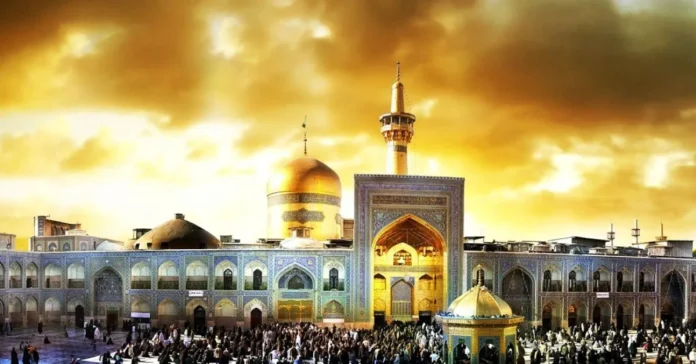Iran is a very historical country from which the Islamic Civilization has taken sanctuary. Having both religious and architectural importance, they have become the symbol of our rich cultural heritage. Iran is filled with sacred spaces, including Zoroastrian temples, Shia shrines, and grand mosques, all reflecting the country’s long history of spiritual belief. scared places of Iran, whether you are on a pilgrimage to heal your spirit or as a traveler looking for ancient history and architecture, the following sacred sites of Iran will not leave anyone indifferent. For Iran, the sacred places are not that simple.
This is where the arts, architecture, and devotion continue to be a living museum. Iranian spiritual icons narrate the country’s rich tapestry of faith, from grand mosques to ancient fire temples Iran is a nation that believes heavily in the intertwining nature of spirituality and tradition (even for us non-practitioners, it’s fascinating to see intersections between these two along with people just living their regular day-to-day lives). There is so much more than heroism and cynicism under those layers, but the question still remains: When we are in a place where history becomes myth — what happens then? Iran tightly interwoven these threads with faith, history, and culture. From corners to its sacred spaces and sites, it gives a deep insight into the tapestry, each of which is a millennium old and has seen spiritual quests happening against cultural evolution. The sacred sites of Iran are more than just places of worship. They are living museums of arts, architecture, and devotion. These spiritual landmarks tell the story of Iran’s rich and diverse religious traditions, from grand mosques to ancient fire temples.
Relevant searches: Angkor Wat Cambodia, Journey into Sacred Beauty
Let’s Dive Into Background and Prestige of Medina
1. Religious places in Iran
Imam Shrine, Mashhad

This country is the largest and one of the most important religious sites. It is the burial place of the eighth Shia Imam, visited by millions of pilgrims each year.
- The golden dome: One of the shrine’s most striking features is its golden dome, which can be seen from miles away.
- Goharshad Mosque: An exquisite mosque within the complex, known for its beautiful tile work and intricate designs.
- Museum and Library: the shrine complex also houses a museum and a library with priceless Islamic manuscripts and artifacts.
Shah Cheragh, Shiraz

Shah Cheragh, meaning king of the light is a mausoleum in Shiraz, southern Iran that houses the tombs of the brothers Ahmad and Muhammad, sons of the seventh Shia Imam, Musa al Kadhim. It is one of the most important image sites in Iran.
- Mirror Work: Intricate mirrorwork adorns the mausoleum’s interior, creating a dazzling effect that captivates visitors.
- Courtyard and Minarets: the complex features a beautiful courtyard surrounded by minarets and a serene atmosphere for reflection.
Jamkaran Mosque, Qom

Located near the holy city of Qom, the Jamkaran Mosque is a significant site for Shia Muslims. It is believed to be associated with Imam Mahdi, the twelfth Shia Imam, who is expected to return as the saviour of humanity.
Notable Aspects
- Weekly Pilgrimage: Thousands of pilgrims visit the mosque every Tuesday to pray and write wishes on paper. They then place these papers in the mosque’s well, believing that their prayers will be answered.
- Architectural Beauty: the mosque’s architecture is stunning, with large domes and minarets that create a peaceful and spiritual ambience.
Fatima Masumeh Shrine, Qom

Another highly revered site is the Fatima Masumeh Shrine in Qom, dedicated to Fatima Masumeh, the sister of Imam Reza. Qom, considered one of the holiest cities in Iran, attracts many pilgrims to the shrine.
- Zarih (shrine): the beautifully decorated shrine of Fatima Masumeh is the focal point of the complex.
- Qom as a Religious Center: Qom is also the center of Shia scholarship in Iran, and numerous religious schools and seminaries surround the shrine.
Nasir al-Mulk Mosque, Shiraz

Also known as the pink mosque, Nasir ul-mulk Mosque in Shiraz is a place of worship and a stunning example of Islamic art and architecture. Although it is not a prominent pilgrimage destination, its tranquil ambiance and stunning beauty make it a sacred place in its way.
What to experience
Glass windows
The mosque’s glass window is so beautiful that it illuminates the praying hall with light and color. You will also find tile work typical of the Qajar era throughout the mosque, such as this beautiful floral pattern.
Zoroastrian Fire Temples
Its followers worshiped fire, and the religion existed long before Islam spread in Iran. However, many people have preserved ancient fire temples, known as Atashgahs, and continue to regard them as sacred. An eternal flame represents the Zoroastrian faith within these temples.
Significant Temples
Atash Behram, Yazd: Yzad is not only the city of one of Iran’s most important fire temples but also a center of Zoroastrian culture. A remote Zoroastrian pilgrimage site in Yazd Province is where people say the daughter of a Persian king, defeated by Islam, found protection.
Sheikh Safi al-din Khanegah and Shrine Ensemble, Ardabil

This UNESCO World Heritage Site in Ardabile.The complex serves as both a spiritual retreat and a mausoleum.
Key attraction
- Elaborate Design: The intricate tile work, frescoes, and calligraphy of the complex represent the peak of Safavid art and architecture, making it renowned.
- Sufi Heritage: the site is a testament to Iran’s rich Sufi traditions and the influence of the Safavid dynasty in spreading Shia Islam.
Tomb of Hafez, shiraz

While not a religious site in the traditional sense, the Tomb of Hafez in Shiraz is sacred to many Iranians who revere the poet’s work. Hafez’s poetry is deeply spiritual and has influenced Persian literature and culture for centuries.
What to see
- Beautiful Garden Setting: The beautiful garden surrounds the tomb, offering a peaceful atmosphere where visitors can reflect on and recite Hafez’s poetry.
2. Summary of scared places in Iran
| Sacred place | Location | Significance | Key features |
| Imam Reza Shrine | Mashhad | Burial place of the 8th Shia Imam | Golden Dome, Goharshad mosque, Museum and Library |
| Shah Cheragh | Shiraz | Mausoleum of Ahmed and Muhammad, sons of the 7th Shia Imam | Mirrorwork, courtyard, Minarets |
| Jamkaran Mosque | Qom | Associated with Imam Mahdi, the 12th Shia Imam | Weekly pilgrimage, Architectural beauty |
| Fatima Masumeh Shrine | Qom | Dedicated to the sister of Imam Reza | Zarih (shrine), center of Shia scholarship |
| Nasir al-Mulk Mosque | Shiraz | Known as the pink mosque an example of Islamic art and architecture | Stained glass windows, tile work |
| Zoroastrian fire temples | various(e.g Yazd) | Sacred sites of the Zoroastrian religion | Atsh Behram (Yazd), Chak chak (Yazd province) |
| Sheikh Safi al-Din | Ardabil | Dedicated founder of the Safavid Sufi order | Elaborate design, sufi heritage |
| Tomb of Hafez | Shiraz | The final resting place of the beloved Persian poet Hafez | Beautiful garden setting, cultural significance |
3. Interesting facts about Iran
The Place of Poetry in Iran’s Living Heritage
Discover the relationship that exists between Iran’s profound literary tradition, with a focus in poetry and its sacred heritage. Focus on the mausoleums of respected poets, such as those in Shiraz, where people consider Hafez and Saadi sacred sites, and explore how poetry has shaped spiritual life in Iran.
Iran Sufism, Mystical places and Worship practice
Here we will study the Sufi tradition in Iran, specifically focusing on its mystical practices and shrines, which Persian people visit during different religious occasions to attain spiritual welfare. Talk about sites such as the tomb of Rumi in Konya Provides turkey, but is culturally linked to (Iranian Sufism) or various significant Iranian shrines.
Iran, Religious festivals and rituals at sacred sites
Describe the religious festivals and rituals celebrated through a network of nine sacred sites in Iran, such as the Muharram mourning ceremonies held at Imam Hussein Shrine. Tell them about these events where a massive number of people participate and how important are they related to the faith, culture & tradition in our country.
Grand Shrines of Iran, A Pilgrim Paradise
Concentrate on the key Shia Muslim shrines in Iran such as Imam Reza Shrine Mashhad and Fatima Masumeh Shrine Qom. This section will show what has been done to provide relief.
Relevant Searches: Sacred Journey CharDham Yatra, Complete Travel Guide
People may ask
1. What is the most important religious site in Iran?
The Imam Reza shrine in Mashhad is Iran’s most important religious site, attracting millions of Shia pilgrims yearly.
2. Are non-Muslims allowed to visit these sacred sites?
Some sites, like the Imam Reza Shrine, restrict access to certain areas where non-Muslims may not be allowed. However, many sacred sites in Iran welcome visitors of all faiths.
3. What is the significance of Zoroastrian fire temples in Iran?
Zoroastrian fire temples are important places of worship for Zoroastrians, where an eternal flame symbolizes purity and the divine presence.
4. How has Iran’s religious architecture influenced other regions?
Iran’s religious architecture, particularly during the Safavid era, has profoundly influenced Islamic architecture across the Middle East and Central Asia.
5. What role does poetry play in Iranian spirituality?
Poetry, especially the work of poets like Hafez and Rumi, plays a significant role in Iranian spirituality. It often reflects deep mystical and religious themes.
Bottom lines
Such hallowed sites in Iran are not merely religious spots; these places are an emblem of the broader spiritual legacy and cultural mosaic that permeates this ancient land. From the grand shrines of Shia Islam to its ancient Zoroastrian temples, every site opens a different chapter in the story that is Iran. From spiritual enlightenment through history to a better understanding of this respected and ancient land, you cannot go wrong by exploring the sacred sites across Iran. The sacred places of Iran have become a part and parcel of the culture with fabric along worth celebrations. Every site speaks a tale of religion, faith and the search for wanting more from life. scared places of Iran proudly testify to the long-lasting faith of its people. These sites have been protected and cherished for generations, representing the spiritual heart of our country. Iran’s holy sites bear witness to the deep faith of their inhabitants. These places have been revered and respected for centuries as they represent the soul of this land.



